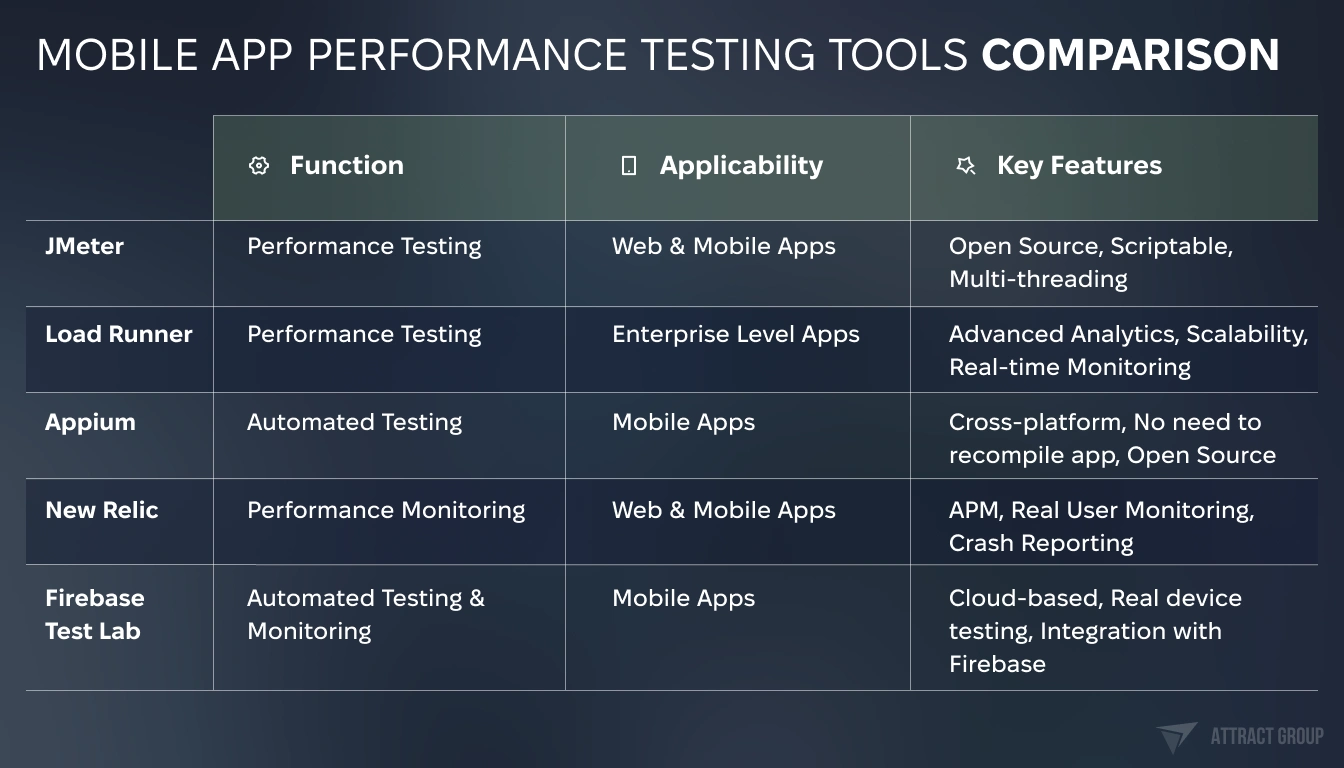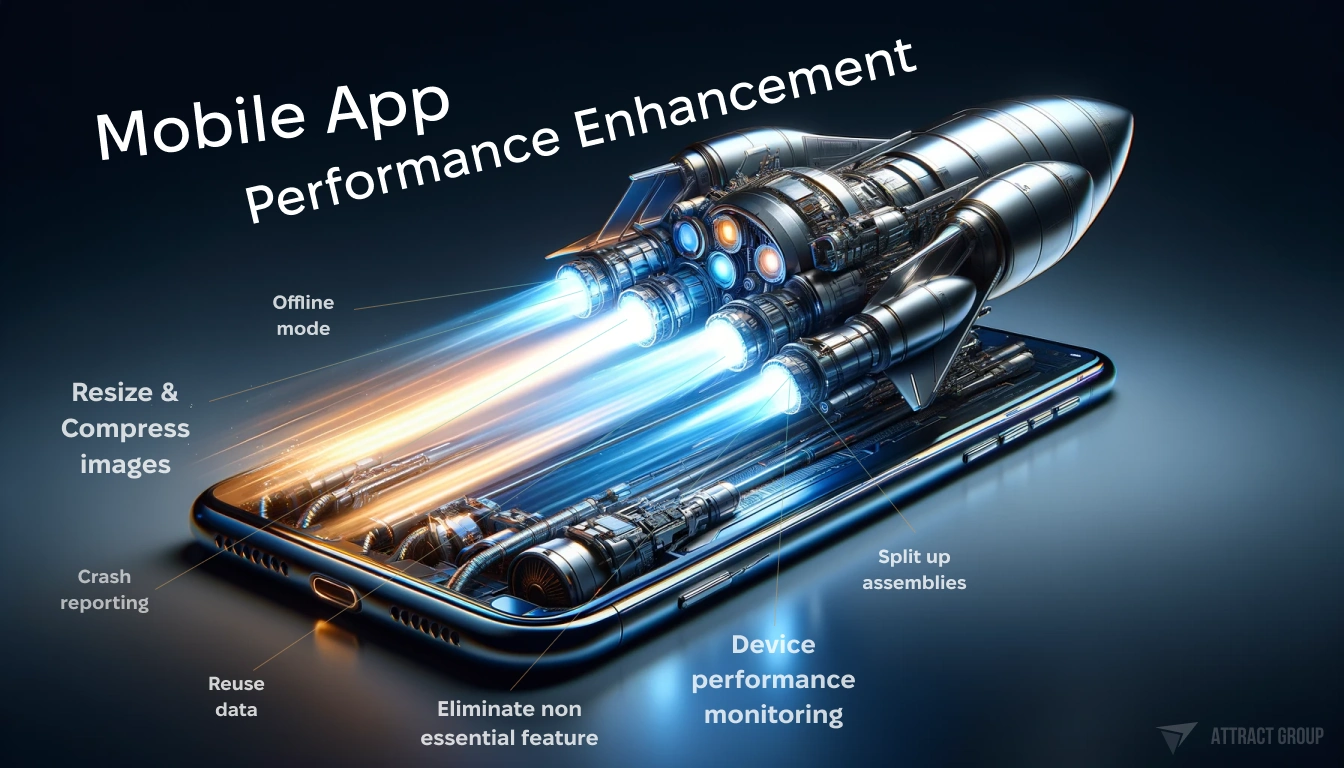Mastering Mobile App Performance: Essential KPIs and Optimization Techniques
 17 November 2023
17 November 2023Hey there, mobile app enthusiasts! If you’re all about maximizing your app’s potential, then you know that mastering mobile app performance is the key to success. Whether you’re an IT entrepreneur or a company owner who is interested in digitizing their businesses seasoned app developer or a newbie in the tech world, understanding the ins and outs of mobile app performance is crucial to ensuring a top-notch user experience. In this article, we’ll dive into mobile app performance, focusing on essential KPIs and optimization techniques to help you take your app to the next level.
With the abundance of mobile performance meter app reviews and mobile performance testing apps out there, it’s easy to feel overwhelmed with where to start. But fear not! We’ve covered you with expert insights and mobile web app performance tips that will empower you to make informed decisions when using your app.
Whether your app is designed for e-commerce, gaming, or social networking, understanding and optimizing its performance is essential for keeping users engaged and satisfied. So please sit back, relax, and prepare to take your app to new heights with our must-know mobile app performance tips and tricks.
Understanding Mobile App Performance Metrics
Mobile app performance metrics are essential to assess a mobile application’s efficiency, effectiveness, and overall experience. These metrics, often called key performance indicators (KPIs), provide vital data that helps developers and businesses understand how their app performs in the real world.
Performance metrics go beyond basic functionality, delving into user satisfaction and the app’s ability to meet its intended goals. These metrics can include various aspects such as load times, response times, error rates, and more, all under the umbrella of mobile app performance management.
Insights into App Functionality and User Satisfaction
The data from performance metrics offer invaluable insights into app functionality and user satisfaction. Key metrics like ratings and reviews offer direct feedback from users, highlighting what they like or dislike about the app.
This feedback is a goldmine for identifying mobile app performance issues and prioritizing areas for improvement. Meanwhile, more analytical metrics like net promoter score (NPS), customer satisfaction score (CSAT), and customer effort score (CES) provide quantifiable measures of user satisfaction. These scores help businesses understand their users’ loyalty and advocacy levels.

Additionally, retention and churn rates are critical metrics in measuring mobile app performance. They clearly show how effectively the app maintains its user base over time. A high retention rate indicates that users find value in the app and continue to use it.
In contrast, a high churn rate might signal underlying problems in functionality or user satisfaction. By monitoring these metrics, businesses can optimize mobile app performance, ensuring that their application functions smoothly and aligns with user expectations and preferences.
Get a free consultation with our mobile app experts to evaluate your app’s current performance metrics against industry standards
Tools and Techniques
Businesses can utilize various tools and techniques to measure mobile app performance effectively.
- Manual Performance Testing: This fundamental approach involves testers simulating user interactions to identify potential performance issues. It’s crucial for uncovering user-specific problems that automated tests might miss. For example, manually testing on different devices helps ensure the app performs well across various hardware specifications.
- Automated Performance Testing Tools: Tools like Apache JMeter and LoadRunner are used for automated performance testing. They simulate many users interacting with the app to test its scalability and load capacity. This helps in identifying how the app behaves under heavy usage conditions.
- Mobile App Performance Monitoring (APM) Tools: New Relic and AppDynamics provide real-time insights into app behavior. They help identify and quickly resolve performance bottlenecks by tracking key metrics like response times, server requests, and memory usage.
- Meteor Mobile App Performance Monitoring: This is an example of a specific tool for apps built with the Meteor framework. It offers specialized insights and optimizations for this particular development environment.
- Crash Reporting Tools: Tools like Crashlytics and Sentry are essential for monitoring app stability. They provide detailed crash reports that help developers quickly identify and fix issues that lead to app crashes.
- Mobile App Performance Benchmarks: Utilizing benchmarks such as Geekbench or AnTuTu helps businesses understand how their app compares to industry standards or competitors. These benchmarks provide a standardized measure of performance across different apps and devices.
- Network Performance Tools: Tools like Charles Proxy and Wireshark monitor and debug network traffic between the app and servers. They help identify network-related performance issues, such as slow API responses or data bottlenecks.
By integrating these tools and techniques into their development and maintenance processes, businesses can ensure their apps meet the required mobile app performance requirements and test cases, leading to a seamless and satisfying user experience. This holistic approach to performance measurement not only aids in maintaining high standards but also in building a robust and reliable mobile application ecosystem.

The Role of Performance Testing in Mobile Apps
Performance testing plays a pivotal role in the world of mobile app development. It is a critical process to ensure that mobile applications meet the desired speed, stability, and scalability standards. The significance of performance testing in mobile apps cannot be overstated; it is essential for maintaining a high level of quality, enhancing user experience, and ensuring the app’s success in a highly competitive market.
This testing approach helps identify performance issues that could hinder app functionality, affect user satisfaction, or cause app crashes. By addressing these issues early, developers can improve mobile app performance, optimize for platforms like Android and iOS, and ensure smooth app launches and updates on app stores.
Necessity of Performance Testing Mobile Apps to Ensure Quality
Performance testing for mobile apps is vital to ascertain that the app functions optimally under various conditions. This includes assessing the app’s performance on different devices, network environments, and user loads.
Developers can identify and mitigate performance issues by testing mobile apps, ensuring a seamless user experience. It’s crucial for app market success, as performance is a key factor influencing user retention and app store ratings. Performance metrics obtained from these tests guide developers in optimizing the overall performance, thus significantly improving mobile app quality.
Different Approaches to Performance Testing for Mobile Apps
The methodologies and tools used to test mobile apps vary based on the app’s requirements and the target platform (Android or iOS). Here’s a table outlining some of these approaches:
| Approach | Description | Key Benefits | Common Tools |
| Load Testing | Simulates high user load to test app behavior | Identifies scalability issues | Apache JMeter, LoadRunner |
| Stress Testing | Tests app limits by overwhelming it with extreme conditions | Determines breaking points | BlazeMeter, NeoLoad |
| Spike Testing | Rapidly increases and decreases user load to assess app response | Checks app performance under sudden changes | LoadUI, Gatling |
| Endurance Testing | Evaluates app performance over an extended period | Ensures stability and memory leak prevention | Appium, Robotium |
Utilizing these different approaches, developers can comprehensively test their app’s performance under various scenarios. Performance testing tools for mobile apps like JMeter, LoadRunner, and Appium help in this regard. This extensive testing ensures that the app meets key performance indicators and is optimized for both the Apple App Store and Android platforms.

App performance monitoring continues post-launch to measure mobile app performance and make necessary adjustments for ongoing optimization. Implementing best practices in performance testing is crucial for developers to improve mobile app performance and secure a strong position in the app market.
Performance testing is an indispensable part of mobile app development. It helps identify and resolve performance issues, optimize the app, and enhance overall quality. These practices not only boost the app’s market performance but also enrich the user’s experience, making it a key factor in the success of mobile applications.
Key Performance Indicators for Mobile Apps
Key Performance Indicators (KPIs) are vital metrics used to evaluate the effectiveness and success of mobile applications. These indicators provide insights into an app’s performance, such as user engagement, satisfaction, and financial returns.
For app developers and marketers, these KPIs are essential tools for gauging the health of their applications, understanding user behavior, and making data-driven decisions to enhance the app’s performance. They are particularly crucial in a competitive market where the ability to attract and retain users significantly impacts an app’s success.
Critical KPIs for Assessing Mobile App Performance
| KPI | Description | Importance for App Success | Measurement Method |
| Churn Rate | The rate at which users stop using the app. | High | Percentage of lost users |
| Retention Rate | Percentage of users who continue to use the app over a specific period. | High | User engagement over time |
| Daily Active Users (DAU) | Number of users who interact with the app daily. | High | Daily user count |
| Session Depth | The number of interactions or pages visited in a single session. | Medium | Depth of engagement per session |
| Customer Lifetime Value (CLV) | Users are expected to generate the total revenue over their lifetime of using the app. | High | Revenue tracking over time |
| Average Screens per Visit | Average number of screens or pages viewed per visit. | Medium | Screen count per session |
| App Downloads | Total number of times the app has been downloaded. | High | Download count |
| Cost per Acquisition (CPA) | The cost of acquiring a new customer. | High | Marketing spend per new user |
| Average Revenue per User (ARPU) | Average revenue generated per user. | High | Revenue divided by user count |
| Cost per Install (CPI) | The cost associated with acquiring a new user through app installation. | High | Advertising spend per install |
| Average Number of Sessions per User | Number of times a user opens the app in a given period. | High | Session tracking |
| API Latency | The time it takes for the app to receive a response from its API calls. | High | Response time measurement |
| App Attribution | Identifying which marketing channels are driving app installs or conversions. | High | Channel performance analysis |
| App Event Tracking | Monitoring specific actions users take within the app. | High | Event count and type analysis |
| App Retention | The percentage of users who return to the app after the first use. | High | User return rate |
| Average Order Value (AOV) | The average value of a purchase transaction. | High | Revenue per transaction |

Utilizing KPIs to Monitor and Improve Mobile App Performance
- Analyze User Engagement and Retention: Focus on metrics like retention rate, DAU, and session depth to understand how users engage with the app. High engagement and retention rates indicate a successful app that meets user needs.
- Optimize User Experience: Monitor load speed, app crashes, and API latency to ensure optimal performance. Poor performance can lead users to abandon an app. Regularly testing and optimizing the app’s performance on different mobile devices and under varying network conditions can significantly improve the user experience.
- Financial Assessment and Marketing Strategy: Use KPIs like CLV, ARPU, CPA, and ROI to assess the financial health of the app. This includes evaluating marketing strategies through CPI and app attribution to understand which channels are most effective for acquiring and retaining users.
- User Behavior Analysis: Utilizing app event tracking and conversion rates can provide insights into user behavior. Understanding users’ actions within the app and what motivates them can help optimize its features and marketing strategies.
- Performance Metrics for Continuous Improvement: Regularly track and analyze KPIs to understand the app’s performance over time. This ongoing analysis allows for timely adjustments and improvements to enhance the overall app experience, thereby retaining current users and attracting new ones.
Our experienced developers can help optimize your app’s performance using the latest tools and techniques. Let us analyze your app today
Incorporating these KPIs effectively into a mobile app’s strategy, whether for iOS or Android, can significantly improve the app’s performance, enhance user satisfaction, and increase financial success. An in-depth understanding of these metrics is essential for any mobile app developer or marketer aiming to create a successful and competitive app in today’s dynamic digital landscape.
Best Practices
- Test Across Multiple Devices: It’s important to test your app across multiple devices to ensure consistent performance and user experience.
- Monitor Load Time: Regularly check the load time of your app to ensure that your app loads quickly, impacting user engagement.
- Conduct Regular Audits: Perform regular audits to identify mobile app performance problems.
- User Experience Focus: Always consider how performance issues affect user experience.
- Analyze Under Different Conditions: Test the performance of your mobile app under various network conditions, battery life, and usage scenarios.
- Iterative Testing: Continuously test and optimize your mobile app performance throughout the development lifecycle.
- Leverage Real User Monitoring: Gather data on how real users engage with the app over a specific period for a more accurate performance assessment.
- Optimize Based on Feedback: Use performance testing results and user feedback to make informed decisions for app improvements.
Properly testing your app is essential for ensuring it performs well on a mobile device under various conditions. This improves the app’s success and ensures that users will not abandon the app due to performance issues. Developers can optimize their mobile app’s performance and user experience by following these best practices and utilizing robust testing tools.

How to Improve Mobile App Performance?
Improving mobile app performance is crucial in today’s digital era, where user expectations constantly evolve. Enhanced performance ensures smoother operation and significantly impacts user satisfaction, retention, and, ultimately, the app’s success.
High-performance mobile apps are more appealing, leading to increased usage and customer loyalty. Understanding and optimizing your app’s performance, especially for platforms like Android and iOS, is essential. Let’s delve into the top strategies for enhancing mobile app performance and the impact of these optimizations.
Strategies to Enhance the Performance of Mobile Apps
1. Efficient Code Optimization: Optimizing the app’s codebase is paramount. This involves refactoring and reviewing the code to identify and remove any unnecessary or redundant elements that could slow down the app. Ensuring the code is efficient and lightweight improves the app speed, resulting in a smoother user experience.
2. Network Performance Management: Mobile apps often rely on network connectivity, and managing this aspect effectively is crucial. Data caching, image compression, and efficient data retrieval strategies can significantly improve network performance. This ensures the app maintains a consistent performance even with fluctuating network conditions.
3. Effective Use of Performance Testing Tools: Utilizing tools like Android mobile app performance testing and JMeter for mobile app performance testing can help identify bottlenecks. By regularly conducting tests such as manual performance testing of mobile apps, developers can comprehensively understand the app’s performance and address issues proactively.
4. Monitoring and Analyzing Performance Metrics: Tools like AppInsight provide valuable insights into mobile app performance monitoring in the wild. Key performance indicators for mobile apps should be continuously monitored to understand how the app performs under different conditions, such as varying battery levels and network environments.
5. User Experience Optimization: Focusing on the user interface and experience is essential. This includes optimizing load times, ensuring the app responds quickly, and providing a seamless experience across different devices and platforms. Users will only abandon an app if it takes less time to load or navigate.
Optimizing a mobile app’s performance directly influences user experience and retention rates. A high-performing app offers faster load times and smoother navigation, which enhances user satisfaction. When an app responds quickly and efficiently, it encourages prolonged usage and loyalty, as users are less likely to seek alternatives.
A deeper app performance audit can reveal specific areas for improvement, enabling developers to tailor their optimization strategies more effectively. In the competitive landscape of mobile apps, ensuring your app performs optimally is not just a requirement but a necessity to stand out and retain users. Successful mobile apps are those that not only meet but exceed user expectations in performance and usability.

Mobile App Performance Testing with JMeter
JMeter, a versatile tool traditionally used for testing web applications, has proven to be equally effective for mobile app performance testing. Understanding how to leverage JMeter for this purpose is vital for developers and testers aiming to enhance user experience, reduce downtime, and ensure the seamless functioning of their mobile applications. This guide focuses on why mobile app performance testing is essential and how JMeter can achieve high-performance mobile apps.
Why Test Mobile App Performance with JMeter?
Testing mobile app performance is integral to understanding your app’s performance across different network conditions, devices, and battery levels. JMeter, renowned for its scalability and robust testing capabilities, is an excellent choice.
It allows the simulation of various user behaviors, offering insights into app performance in real-world scenarios. Using JMeter, you can conduct comprehensive tests, including load, stress, and spike testing, ensuring your app withstands varying user demands. This approach helps identify performance bottlenecks, optimize resource usage, and enhance app reliability.
Guide to Using JMeter for Mobile App Performance Testing
To use JMeter for mobile app performance testing effectively, follow these steps:
- Set Up JMeter: Download and install Apache JMeter. Ensure your testing environment mimics the production environment as closely as possible.
- Configure Your Mobile Device: Connect your mobile device to the same network as your JMeter instance. This setup is crucial for capturing accurate traffic data.
- Record the Mobile App Traffic: Use JMeter’s recording feature to capture the traffic from the mobile app. This process involves configuring the mobile device to use JMeter as a proxy server, enabling JMeter to record all requests sent from the app.
- Create Test Plans: Analyze the recorded traffic to create test plans. These plans should reflect real-world usage scenarios, incorporating concurrent user sessions, varying data inputs, and different user paths through the app.
- Integrate Performance Monitoring Tools: AppInsight and enterprise mobile app performance monitoring software can be integrated with JMeter for more in-depth analysis.
- Execute Tests and Analyze Results: Run and analyze the tests using JMeter’s reporting features. Pay attention to key performance indicators like response time, error rate, and throughput.
- Refine and Repeat: Based on the results, make necessary adjustments to your app and repeat the testing process until the desired performance level is achieved.
Step-by-Step Instructions on Setting Up and Interpreting JMeter Results
- Step 1: Install JMeter and set up your testing environment. Configure JMeter to mimic the user behavior under test.
- Step 2: Define your test cases and scenarios. Include common operations and tasks that users perform on the app.
- Step 3: Execute the test plan. Start with a few users and gradually increase to understand how the app performs under different load conditions.
- Step 4: Monitor the results in real-time. JMeter provides several listeners and reports that help visualize the test results.
- Step 5: Analyze key metrics like average response time, peak response time, error rate, and throughput. These metrics give an insight into the app’s performance and scalability.
- Step 6: Identify bottlenecks and performance issues. Look for patterns in the data that indicate potential problems.
- Step 7: Make optimizations based on the findings. This could involve code changes, infrastructure adjustments, or configuration tweaks.
- Step 8: Repeat the tests after making changes. This iterative process helps in progressively enhancing the app’s performance.
With the help of these steps, you can effectively use JMeter for mobile app performance testing, ensuring your app delivers a high-quality, reliable user experience. Remember, performance testing is ongoing; regular testing is key to maintaining an app’s performance over time.
Performance Monitoring and Management for Mobile Apps
Continuous performance monitoring is crucial for maintaining mobile apps’ health and user satisfaction. This process involves regularly tracking performance metrics to ensure the app operates efficiently and effectively.
Developers and app managers can quickly identify and resolve issues like slow response times, crashes, or memory leaks by consistently monitoring performance. This proactive approach to managing app performance is essential in a competitive market where users expect high-quality, reliable experiences.
The importance of continuous monitoring cannot be overstated. It provides real-time insights into an app’s behavior in different environments and user scenarios. For instance, using tools like “AppInsight: Mobile App Performance Monitoring in the Wild” or “Mobile Performance Meter,” developers can gather data on app performance across different devices and operating systems (iOS and Android).
This data helps understand an app’s performance over different battery conditions, network environments, and user interactions. It also aids in formulating mobile app performance Key Performance Indicators (KPIs), which are vital for measuring the success and efficiency of the app. Continuous monitoring helps identify trends and patterns in app usage, enabling developers to optimize the app’s performance and improve user experience.
Tools and Practices for Efficient Mobile App Performance Management
| Tool/Practice | Purpose | Platform (iOS/Android) | Key Features |
| AppInsight | In-depth performance monitoring | Both | Real-time analytics, user interaction tracking |
| Mobile Performance Meter | User experience and performance monitoring | Both | Network performance data, device compatibility checks |
| Appium | Automated performance testing | Both | Cross-platform testing supports multiple languages |
| Application Performance Report | Analyzing performance metrics | Both | Comprehensive performance data, trends analysis |
| High-Performance Mobile Apps Guide | Best practices and strategies | Both | Tips for optimization, case studies |
These tools and practices are fundamental in understanding and improving your app’s performance. They help set up effective performance test cases and utilize mobile app performance testing using Appium or similar frameworks. They provide valuable insights into how to performance test mobile apps, ensuring that the app maintains high functionality and user satisfaction standards.
Mobile app developers and managers can significantly improve performance by integrating these tools into the development and maintenance processes. This leads to enhanced user experiences, increased user retention, and the app’s success in a highly competitive market.

Challenges and Solutions in Mobile App Performance
In the digital age, the performance of mobile applications is crucial to their success. With millions of users frequently using apps for various purposes, ensuring seamless, efficient, and effective performance is necessary. Mobile app performance refers to the responsiveness, speed, and reliability of an app as experienced by users. It plays a pivotal role in determining the success of the app.
Performance issues can lead to decreased user satisfaction, reduced usage, and, ultimately, a decline in the app’s success. Thus, understanding and improving your mobile app’s performance is vital for maintaining user engagement and satisfaction. This guide provides a comprehensive overview of the common performance issues encountered in mobile apps and the techniques to address them, ensuring your mobile app performs optimally for all mobile users.
Common Performance Issues and Solutions in Mobile Apps
Issues and Solutions:
- Slow Load Time: The app’s load time is critical. Users expect quick access to apps; delays can lead to frustration and app abandonment. To improve app performance in this regard, optimize image sizes, streamline code, and use lazy loading techniques.
- Battery Drain: An app that excessively consumes battery power can deter users. To ensure performance over different battery lives, optimize code for energy efficiency, and avoid unnecessary background processes.
- Memory Leaks: These can cause apps to slow down or crash. Regular mobile app performance testing using tools like JMeter can help identify and fix memory leaks.
- Unresponsive UI: A responsive interface is essential for user satisfaction. Implement efficient UI design practices and ensure that the main thread is used for UI updates only.
- Network Issues: Mobile apps often struggle with varying network conditions. Implementing offline modes and optimizing data loading strategies can help mitigate these problems.
- Inefficient Data Storage: Optimizing database queries and using efficient data storage methods can significantly improve app performance.
Monitoring and Reporting:
- Utilize mobile app performance monitoring enterprise software companies to regularly track and understand your app’s performance.
- Conduct regular mobile app performance test cases and generate performance reports for continuous improvement.
Techniques for Troubleshooting and Resolving Performance Problems
- Profiling and Benchmarking: Use tools to profile the app and benchmark its performance under various conditions. This helps in identifying bottlenecks.
- Performance Testing: Implement mobile app performance testing using tools like JMeter to simulate user scenarios and measure app responsiveness.
- Monitoring Key Performance Indicators (KPIs): Track mobile app performance KPIs to understand how the app is performing and where improvements are needed.
- User Feedback: Gathering feedback from mobile app users can provide insights into performance issues from the user’s perspective.
- Updating and Optimizing Code: Regularly update the app to fix known issues and optimize code for better performance.
- Utilizing Latest Technologies: Stay updated with the latest technological advancements, especially for Android apps, to leverage new methods to improve your mobile app’s performance.
Addressing these challenges and implementing the appropriate solutions and techniques is essential to ensure your mobile app meets the expectations of today’s mobile users. Regular monitoring, testing, and optimizing are key to maintaining and improving your app’s performance, ultimately contributing to its overall success.
Don’t let performance issues slow your app down. Our optimization services deliver faster, smoother mobile apps your users will love
Conclusion
In mastering mobile app performance, focusing on essential Key Performance Indicators (KPIs) and optimization techniques is crucial. High-performance mobile apps are not just about aesthetics; they embody efficiency, responsiveness, and reliability.
Understanding your app’s performance through metrics like load time, user engagement, and crash reports is paramount. This approach not only aids in identifying areas for improvement but also ensures that apps like mobile performance meters are functioning optimally.
Testing plays a critical role in this journey. Employing methods like a mobile app performance testing checklist, utilizing tools such as LoadRunner for mobile app performance testing, and conducting mobile native app performance testing are effective strategies to gauge and enhance app performance. A proactive stance in app performance optimization, including regular updates and refinement, significantly boosts overall functionality.
Encouraging a proactive approach to performance management is key. Regularly engaging in performance testing on mobile apps and employing a mobile performance meter app hack ensures that your app meets user expectations and helps preemptively address potential issues.
This guide to improve mobile app performance is not just a set of instructions. It’s a commitment to excellence and user satisfaction. In conclusion, a thorough understanding and continual improvement of mobile app performance can transform how users interact with your app, solidifying its place in the competitive digital landscape.










